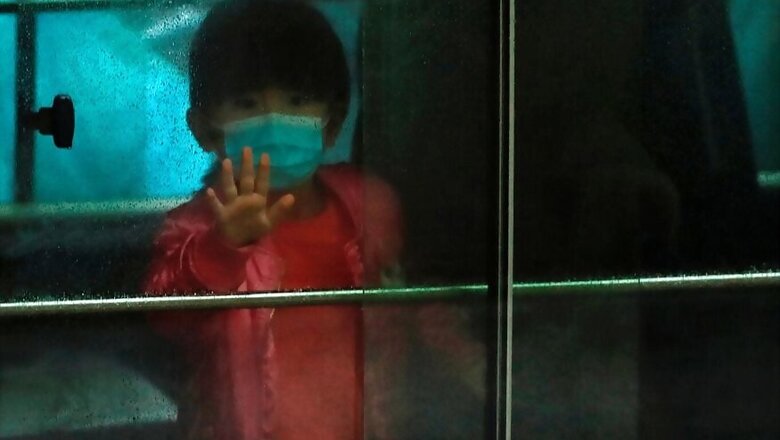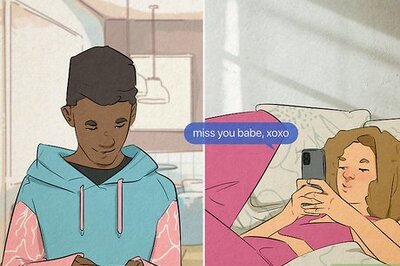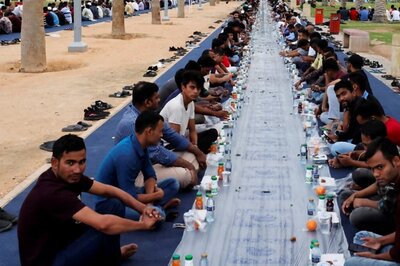
views
Last week, I received an email from my children’s principal, sharing some of the first details about plans to reopen New York City schools this fall. The message explained that the city’s Department of Education, following federal guidelines, will require each student to have 65 square feet of classroom space. Not everyone will be allowed in the building at once. The upshot is that my children will be able to physically attend school one out of every three weeks.
At the same time, many adults — at least the lucky ones that have held onto their jobs — are supposed to be back at work as the economy reopens. What is confusing to me is that these two plans are moving forward apace without any consideration of the working parents who will be ground up in the gears when they collide.
Let me say the quiet part loud: In the COVID-19 economy, you’re allowed only a kid or a job.
Why isn’t anyone talking about this? Why are we not hearing a primal scream so deafening that no plodding policy can be implemented without addressing the people buried by it? Why am I, a food blogger best known for such hits as the All-Butter Really Flaky Pie Dough and The ‘I Want Chocolate Cake’ Cake, sounding the alarm on this? I think it’s because when you’re home-schooling all day and not performing the work you were hired to do until the wee hours of the morning, and do it on repeat for 106 days (not that anyone is counting), you might be a bit too fried to funnel your rage effectively.
For months, I’ve been muttering about this — in group texts, in secret Facebook groups for moms, in masked encounters when I bump into a parent friend on the street. We all ask one another why we aren’t making more noise. The consensus is that everyone agrees this is a catastrophe, but we are too bone-tired to raise our voices above a groan, let alone scream through a megaphone. Every single person confesses burnout, despair, feeling like they are losing their minds, knowing in their guts that this is untenable.
It should be obvious, but a nonnegotiable precondition of “getting back to normal” is that families need a normal to return to as well. But as soon as you express this, the conversation quickly gets clouded with tangential and irrelevant arguments that would get you kicked off any school debate team.
“But we don’t even know if it’s safe to send kids back to school” is absolutely correct, but it’s not the central issue here. The sadder flip side — the friend who told me that if their school reopens, her children are going back whether it’s safe or not because she cannot afford to not work — edges closer.
“Why do you want teachers to get sick?” isn’t my agenda either, but it’s hard to imagine that a system in which each child will spend two weeks out of every three being handed off among various caretakers only to reconvene in a classroom, infinitely increasing the number of potential virus-carrying interactions, protects a teacher more than a consistent pod of students week in and out with minimized external interactions.
“You shouldn’t have had kids if you can’t take care of them” is comically troll-like but has come up so often, one might wonder if you’re supposed to educate your children at night. Or perhaps you should have been paying for some all-age day care backup that sat empty while kids were at school in case the school you were paying taxes to keep open and that requires, by law, that your child attend abruptly closed for the year.
“Why aren’t you enjoying the extra quality time with your kid?” lays bare what is really simmering below the surface: a retrograde view that maybe one parent (they mean the mom) shouldn’t be working, that doing so is bad for children, that it’s selfish to pursue financial gains (or solvency, as working parents will tell you). It is a sentiment so deeply woven into our cultural psyche that making the reasonable suggestion that one shouldn’t have to abandon a career or livelihood if offices reopen before schools, day cares and camps do is viewed as a chance to redeliberate this.
It is not, and you’re off the debate team, too.
I’ve heard from parents who have the luck of a grandparent who can swoop in or the deep pockets for a full-time nanny or a private tutor for their child when schools are closed. That all sounds enviable, but it would be absurd to let policy be guided by people with cushioning. If you have the privilege to opt out of the workforce and wish to, enjoy it. But don’t wield it as a stick to poke others with because far more people are being forced to “opt out” this year and will never professionally or financially recover.
I resent articles that view the struggle of working parents this year as an emotional concern. We are not burned out because life is hard this year. We are burned out because we are being rolled over by the wheels of an economy that has bafflingly declared working parents inessential.
Part-Time Teachers, Full-Time Parents
For context, let me tell you how the last few months have been for my family. The first few weeks of school and business closures were jaw-clenchingly stressful. I am self-employed and worked full time from home already, so that part required no transition. But I needed to use this flexibility to ensure that my husband, who would normally have been at his office, didn’t miss a meeting, call or email while I managed the remote-learning curricula of our two children, one in pre-K, one in fifth grade. I compensated by working until about 2 a.m. each night.
Three weeks later, our marital work-balance stress evaporated as my husband was put on furlough. He took over home-schooling and basically everything else as I became the sole breadwinner, trying to work as hard as I could at every hour. Last week, he was fully laid off.
Despite our own financial strain, we’ve continued to pay the nanny who used to help shuttle the kids around while we worked, even though she hasn’t worked for us since March. Even if we asked for her help in home-schooling our children this fall, who would do so for her school-age children? When will my husband be able to look for work? How can he go back to work if there’s no one to watch the kids?
And I speak from a position of significant privilege. We were, until recently, a two-income family with savings, paying for more than the minimum of child care hours that we needed each day just to cover what-ifs, living in one of the most expensive cities on earth. We have laptops, tablets, Wi-Fi, and didn’t think twice before panic-ordering pencils, paper, markers and anything else we thought might help our children.
But my family, as a social and economic unit, cannot operate forever in the framework authorities envision for the fall. There are so many ways that the situation we’ve been thrust into, in which businesses are planning to reopen without any conversation about the repercussions on families with school-age children, is even more untenable for others.
Under the best of circumstances, the impact on children will still be significant. Students will lose most of a year of learning as parents — their new untrained teachers — cannot supervise in any meaningful way while Zooming in to the office. At best, the kids will be crabby and stir-crazy as they don’t get enough physical activity because they’re now tethered to their parents’ workspaces all day, running around the living room in lieu of fresh air. Without social interactions with other children, they constantly seek parental attention in bad ways, further straining the mood at home. And these are ideal scenarios.
But what about kids who cannot learn remotely? What about kids who need services that are tied to schools? Or those who are at higher risk for complications if they get the virus and might not be able to go back even one week out of the three?
When learning plans for children with special needs could not be followed appropriately this year, academic gains for many students were quickly wiped out. Remote learning has already widened racial and socioeconomic achievement gaps because of disparities in access to technology tutors. As parents are crushed by the COVID economy, so are the children who need the most support. It’s no wonder the American Academy of Pediatrics released a statement this weekend urging that students be physically present in school as much as possible this fall.
The long-term losses for professional adults will be incalculable, too, and will disproportionately affect mothers. Working mothers all over the country feel that they’re being pushed out of the labor force or into part-time jobs as their responsibilities at home have increased tenfold.
Even those who found a short-term solution because they had the luxury to hit the pause button on their projects and careers this spring to manage the effects of the pandemic — predicated on the assumption that the fall would bring a return to school and child care — may now have no choice but to leave the workforce. A friend just applied for a job and tells me she cannot even imagine how she would be able to take it if her children aren’t truly back in school. There’s an idea that people can walk away from careers and just pick them up where they left off, even though we know that women who drop out of the workforce to take care of children often have trouble getting back in.
And lest you think it’s everyone versus teachers, I cannot imagine a group this situation is less fair to. Teachers are supposed to teach in the classroom full time but simultaneously manage remote learning? Even in nonpandemic times, teachers would tell you that they already work unpaid overtime on nights and weekends just planning and grading. Where, exactly, will the extra hours come from? For teachers with their own school-age children, the situation isn’t just untenable; it’s impossible.
The Wealthy Win. Again.
Without a doubt, reopening schools is a colossal undertaking. There are no easy solutions to finding enough space for students to socially distance; ensuring teachers and staff are protected; adding more sinks and cleaning staff; and implementing widespread temperature checks, testing and contact tracing.
But after nearly four months since the lockdowns began — four months of working all hours, at remarkable stress levels, while our children have gone without play dates and playgrounds and all of the other stimuli that help them thrive — most parents have been shocked to find that state governments don’t have any creative or even plausible solutions.
For parents who cannot simply sort it out, our national response feels more like a dystopian novel where only the wealthy get to limit their exposure and survive the pandemic unscathed. Allowing workplaces to reopen while schools, camps and day cares remain closed tells a generation of working parents that it’s fine if they lose their jobs, insurance and livelihoods in the process. It’s outrageous, and I fear if we don’t make the loudest amount of noise possible over this, we will be erased from the economy.
Deb Perelman c.2020 The New York Times Company


















Comments
0 comment